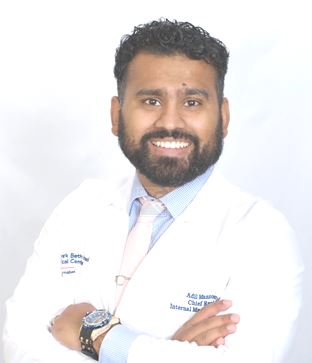THE DOCTOR IS IN

OP / ED BY DR. ADIL MANZOOR
News flash – there is a medical debt problem in the United States. Well, to be fair, this shouldn’t be all that surprising, considering we have a debt problem in virtually all sectors of our economy. While all types of debt problems are certainly concerning, the medical debt problem is even more disturbing and worrying. Here’s why.
A survey from the Urban Institute of close to ten thousand people between the ages of 18 and 64 found that low-income people were affected to a greater extent by overdue medical debts. From the survey data, individuals with incomes at or below the federal poverty threshold had the most debt. Perhaps unsurprisingly, the number of people with overdue medical debts fell as income increased.
Another key aspect of the survey is the race of the people entrenched in this medical debt problem. As you may expect, people of color – particularly Blacks and Hispanics – were more affected than their white counterparts. In fact, the number of black individuals affected by medical debts was more than double that of white people with the same problem.
One last statistic that will interest you from the report is that most of the medical debts owed were owed to hospitals. And forgive me, but I have another interesting statistic from the report: people who owed hospitals had significantly more debt than those who owed non-hospital providers. To be exact, 71.5 percent of individuals in the survey who owed hospital providers owed more than $1000, while that figure stood at 32.6 percent for respondents that owed non-hospital providers.
What exactly do these figures mean? Well, for starters, the survey report establishes that we indeed have a medical debt problem in the United States. That scares me, considering just how increasingly difficult it is for Americans to survive on their income. Then, it gets even worse.
Most of the people who are affected by this medical debt problem are people who aren’t financially comfortable to start with. So, the medical debts do nothing but compound their already complicated financial problems. Take a moment to consider how dangerous this can be. People with the most medical debts don’t earn much to begin with, which means many of them may have to work multiple jobs to support themselves. This leads to them stressing themselves even more, further increasing the risk of getting more medical issues. It’s a vicious cycle.
Again, people of color are even more affected than white Americans. I don’t want to bore you with figures and numbers, but people of color in the United States usually bear more of the brunt of economic challenges in the country. So, these people of color aren’t in the best position economically to begin with, and then the fact that they suffer more from the medical debt problem only compounds their economic problems.
Aside from working other jobs, people with medical debt problems also have to cut spending on food, clothing, and other basics, according to the Kaiser Family Foundation Health Care Debt Survey. Also, these individuals have used up all or most of their savings, they have delayed purchasing a home or furthering their education, sought aid from charity, and even declared bankruptcy and lost their homes.
Of course, we can spend all day pointing fingers and trying to figure out whose fault the medical debt problem actually is. But that will change nothing unless it is backed up by action. Actual action from the government, the management of hospitals, insurance companies, and other stakeholders in the health sector. My hopes are not high, though, considering just how capitalistic the United States is.
There seems to be a passion among the very people who can implement a change to suck every last penny in the medical health industry. I am trying my best to restrain from a rant about the medical industry. I can say is this, though – if the medical debt problem in the United States is not addressed soon, we risk entering a full-blown crisis in an already over-inflated medical health industry.
This article was written by Dr. Adil Manzoor, DO, a Board-Certified Internist & Board Certified Pediatrician who works as a Hospitalist and Emergency Room Physician. He is also the current President of Garden State Street Medicine, a non-profit organization whose sole purpose is to provide free preventive and acute urgent care services for the homeless. He is also the co-founder of his own unique medical practice, Mobile Medicine NJ & House call Doctors. He is also currently pursuing an Executive MBA and a Master’s of Science in Healthcare Leadership at Samuel Curtis Johnson Graduate School of Management and the Weill Cornell Graduate School of Medical Sciences.
References
- https://www.cnbc.com/2022/06/22/100-million-adults-have-health-care-debt-and-some-owe-10000-or-more.html`
- https://www.spokesman.com/stories/2023/mar/18/americans-are-knee-deep-in-medical-debt-most-owe-h/
- https://www.whitehouse.gov/briefing-room/statements-releases/2023/02/14/fact-sheet-new-data-show-8-2-million-fewer-americans-struggling-with-medical-debt-under-the-biden-harris-administration/

